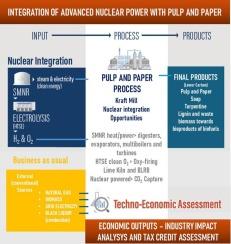Advanced nuclear reactor integration opportunities for the pulp and paper industry in the U.S. context: Technical perspectives, gap analysis, and preliminary technoeconomic assessment
IF 7
2区 工程技术
Q1 ENERGY & FUELS
Sustainable Energy Technologies and Assessments
Pub Date : 2025-09-16
DOI:10.1016/j.seta.2025.104582
引用次数: 0
Abstract
Pulp and paper (P&P) manufacturing requires a large amount of low-pressure (LP) steam to digest, wash wood fibers and dry pulp into paper. Most of the LP steam is extracted from backpressure turbines that produce power from high-pressure (HP) steam. This HP steam is generated from burning wood waste material; bark is burned in hog boilers, and lignin is boiled in a black liquor recovery boiler. In a typical integrated P&P mill, 50–100% of the steam is produced from these sources, while additional steam is produced in natural gas (NG), fuel oil, or coal boilers. The other energy-intensive process in the plant is the chemical-recovery section (e.g., lime kiln), which requires high-temperature processing from NG combustion to retrieve and recirculate spent chemicals. This paper assesses the energy and heat demand and material balances of a typical generic kraft pulp mill, along with the nuclear heat, steam, and power integration opportunities to replace conventional combustion systems. The paper also addresses steam and electricity generation through a comprehensive technical and engineering gap analysis of five different nuclear-integration opportunities and their process economics, thus enabling the lignin and bark to be further processed into biobased chemicals or fuels, as well as the potential to reduce overall emissions from kraft pulping. Preliminary findings have shown that the P&P industry could achieve technological benefits by integrating their current manufacturing process with small modular nuclear reactors (SMNRs) on a national level. This research aims to set the path forward for a cleaner and more resilient P&P industry.

美国制浆造纸工业的先进核反应堆整合机会:技术观点、差距分析和初步技术经济评估
纸浆和造纸(P&;P)制造需要大量的低压(LP)蒸汽来消化、洗涤木纤维和干燥纸浆成纸。大多数低压蒸汽是从背压涡轮机中提取的,背压涡轮机从高压(HP)蒸汽中发电。这种高压蒸汽是由燃烧木材废料产生的;树皮在生猪锅炉中燃烧,木质素在黑液回收锅炉中煮沸。在一个典型的综合P&;P工厂中,50% - 100%的蒸汽来自这些来源,而额外的蒸汽则来自天然气(NG)、燃料油或煤锅炉。工厂中的另一个能源密集型过程是化学回收部分(例如石灰窑),这需要从天然气燃烧中进行高温处理,以回收和再循环废化学品。本文评估了一个典型的通用硫酸盐纸浆厂的能源和热需求以及物料平衡,以及取代传统燃烧系统的核热、蒸汽和电力集成机会。本文还通过对五种不同的核整合机会及其过程经济进行全面的技术和工程差距分析来解决蒸汽和发电问题,从而使木质素和树皮能够进一步加工成生物基化学品或燃料,以及减少硫酸盐纸浆总体排放的潜力。初步调查结果表明,P&;P工业可以通过在国家层面上将其目前的制造过程与小型模块化核反应堆(SMNRs)集成来实现技术效益。这项研究旨在为一个更清洁、更有弹性的p&p行业设定前进的道路。
本文章由计算机程序翻译,如有差异,请以英文原文为准。
求助全文
约1分钟内获得全文
求助全文
来源期刊

Sustainable Energy Technologies and Assessments
Energy-Renewable Energy, Sustainability and the Environment
CiteScore
12.70
自引率
12.50%
发文量
1091
期刊介绍:
Encouraging a transition to a sustainable energy future is imperative for our world. Technologies that enable this shift in various sectors like transportation, heating, and power systems are of utmost importance. Sustainable Energy Technologies and Assessments welcomes papers focusing on a range of aspects and levels of technological advancements in energy generation and utilization. The aim is to reduce the negative environmental impact associated with energy production and consumption, spanning from laboratory experiments to real-world applications in the commercial sector.
 求助内容:
求助内容: 应助结果提醒方式:
应助结果提醒方式:


